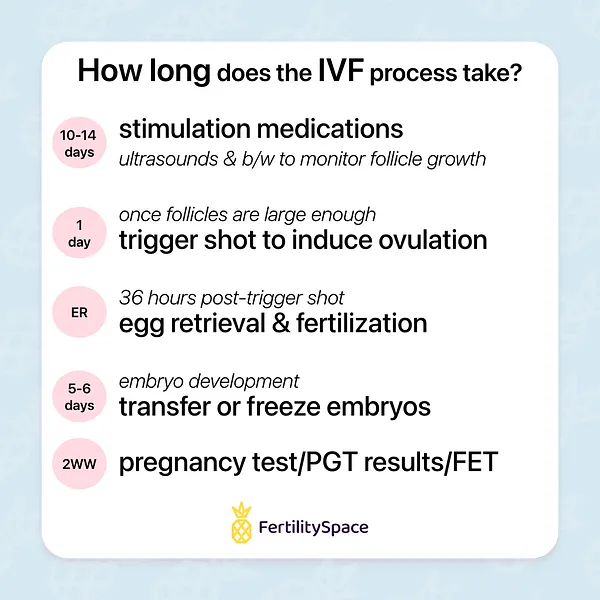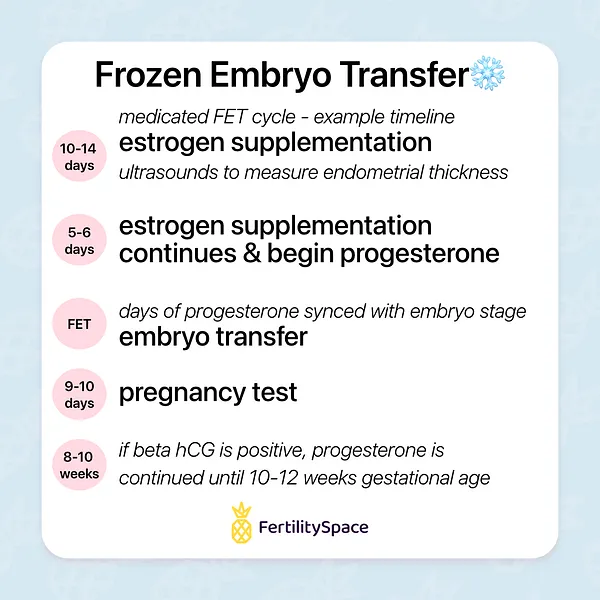Guides
A Guide to the IVF Process & Timeline

Step-by-step guide of the IVF process
"How long does the IVF process take from start to finish?"
This one of the most commonly asked questions about starting in vitro fertilization and like most things, it totally varies based on the person.
Factors such as:
- what day of your menstrual cycle you are on
- how you respond to fertility medications
- your personal life schedule
can affect the number of months it will take you to get from your initial consultation with a fertility specialist to an embryo transfer and subsequent pregnancy test.
For the sake of simplicity, let’s assume that you follow the standard path of the IVF process with no delays. Even then, it's not a quick process.
The IVF process can take 3-4 months from your initial consultation to the time you actually have your first beta hCG test to see if you’re pregnant.
Here’s a basic breakdown of what will occur for each of those months to help you reach your goal of growing your family.
💌 🙏 Review your fertility doctor on our site! Takes less than 30 seconds but really helps other women who are getting started on their fertility journey! 💕
💌 🙏 Review your fertility doctor on our site! Takes less than 30 seconds but really helps other women who are getting started on their fertility journey! 💕
Month 1 - Consultation and testing
The first thing you’ll do is meet with a reproductive endocrinologist to go over your medical history, fertility goals, and have fertility testing.
If you haven't found a fertility clinic yet, check out fertility clinics in your area here. You can also use our guide to choosing a fertility clinic.
Your first visit may include:
If you haven't found a fertility clinic yet, check out fertility clinics in your area here. You can also use our guide to choosing a fertility clinic.
Your first visit may include:
- blood tests for hormones & infectious diseases
- transvaginal ultrasound to estimate your ovarian reserve
- partner's semen analysis (if you have a male partner)
Many fertility tests are time-sensitive and some can only be done on specific days of your menstrual cycle, typically Day 2 or 3 of your cycle.
At some clinics your initial testing is done before having a consultation with the doctor so that he or she already has the results by the time you meet. That way, you can get down to discussing treatment options and protocols right away.
Infertility testing (blood work):
- Estrogen (E2)
- Progesterone (P4)
- Luteinizing Hormone (LH)
- Follicle Stimulating Hormone (FSH)
- Anti-mullerian Hormone (AMH)
- Thyroid Hormones (TSH, T3, T4)
- Prolactin
- Testosterone
- Infectious diseases (Hep B, Hep C, RPR, HPV, HIV, etc)
- Red blood cell count
- Other blood tests specific to your medical history
Your hormone levels will inform your physician of your reproductive health, ovarian reserve, and what type of medication protocol they will suggest for you.
Infertility testing (exams):
- Baseline ultrasound to count the number of follicles on each ovary
- Pelvic exam
- SIS/SHG to evaluate your uterus for any abnormalities such as fibroids, polyps, or scarring
- HSG to check if the fallopian tubes are open; it's more commonly done prior to IUI
- Hysteroscopy to evaluate the uterine cavity & remove any abnormalities that could affect embryo implantation such as polyps; less commonly ordered
- Laparoscopy which is a surgical procedure typically done for endometriosis diagnosis or treatment
Male infertility testing (if applicable):
- Infectious disease blood work
- Semen Analysis
- pH
- Volume
- Concentration
- Count
- Motility
- Morphology
The blood work, ultrasound, and semen analysis are important factors in helping your physician evaluate what treatment is best for you, the medication protocol needed, and give an estimate how many eggs you could get from an IVF cycle.
If you get all of your initial testing completed in your first month, then you can likely jump into your first treatment cycle by your next period.
Month 2 - Start IVF cycle / finish up any testing you missed in Month 1
If you missed any Cycle Day 2-3 testing the previous month, you would need to finish this up during the second month before starting IVF.
If you’ve finished all of your necessary testing the previous month and have had time to meet up with your doctor to discuss next steps, you can likely start an in vitro fertilization cycle by the second month.
If you’ve finished all of your necessary testing the previous month and have had time to meet up with your doctor to discuss next steps, you can likely start an in vitro fertilization cycle by the second month.
For your IVF cycle, you will either do a fresh embryo transfer or you will freeze all of your embryos and your transfer will be scheduled for the next month, known as a frozen embryo transfer (FET).
Important to-do's prior to the IVF start date:
If you're using insurance coverage
- get prior authorization from insurance
- get any prior authorization from insurance for medications
- have medication prescriptions sent to your pharmacy
- read our IVF insurance guide on common misconceptions when using infertility coverage
- read our guide on estimating the cost of IVF with insurance
If you're not using insurance and are self-pay
- pay for your IVF cycle/set up payment plan
- shop around pharmacies for best medication prices
- have medication prescriptions sent to your pharmacy
- read our tips on saving to afford IVF
- read our guide on how to deduct IVF on your taxes
You may have to go on birth control for a number of weeks to get you to baseline before you start your stimulation medications.
IVF Cycle Timeline
You'll call your clinic on Day 1 of your period.
The you'll go in to the clinic on Day 2 or 3 for an ultrasound and bloodwork. At this point, your doctor will be able to clear you to begin the cycle.
You'll be given a treatment calendar listing which medications to start on what days.
All in all, your IVF cycle takes the better part of about 2 weeks for the medications and then roughly another week until you find out how many embryos have developed and can be transferred or frozen.
If your embryos are developing normally, you can plan for a transfer or freezing of your embryos for later use.
Do you like your fertility clinic? 💌 🙏 Review your fertility doctor on our site! Other women need your opinion to help them choose a great fertility provider!
IVF Medications
The number of days you take stimulation medications is unique to you. The stimulation duration depends on how an individual responds to the medication. Some patients need more days of injections, some need less.
As far as the exact medications you will use, it depends on what protocol your physician puts you on. Not everyone responds to the same medication protocol.
Examples are the GnRH agonist long, GnRH antagonist, & minimal stim protocols.
Here is an example of medications used for the GnRH antagonist protocol:
- FSH (brand names: Gonal-F, Follistim, etc)
- FSH + LH (brand name: Menopur)
- GnRH Antagonist (brand names: Ganirelix, Cetrotide)
- hCG trigger (brand names: Pregnyl, Novarel, Ovidrel, etc) or Lupron trigger
If you will be self-pay for medications, you may want to shop around different pharmacies & compare different brand names to keep the cost as low as possible. IVF medications alone can be around $5k-$7k for a single IVF cycle.
Month 3 - Frozen embryo transfer (FET) or Mock Cycle
Ok, at this point hopefully you have some embryos frozen!
A frozen embryo transfer can be done following your natural cycle without medications or can be a controlled cycle where you will take medications to help your uterine lining grow and time your embryo transfer date more accurately.
A frozen embryo transfer can be done following your natural cycle without medications or can be a controlled cycle where you will take medications to help your uterine lining grow and time your embryo transfer date more accurately.
If you have multiple embryos to choose from, your care team will likely use PGT results as well as embryo morphology to choose which embryo is recommended for transfer.
Some women may have to take birth control pills or Lupron to begin to prevent natural ovulation.
You will then take estrogen and progesterone to help grow your uterine lining & prepare it to be receptive to implantation. You take estrogen for about 2 weeks before including progesterone for another 5-6 days.
If you are prescribed progesterone in oil for the FET and you're nervous about the giant needle needed for this injection, check out our tips on how to make the progesterone in oil shots less painful.
You will then take estrogen and progesterone to help grow your uterine lining & prepare it to be receptive to implantation. You take estrogen for about 2 weeks before including progesterone for another 5-6 days.
If you are prescribed progesterone in oil for the FET and you're nervous about the giant needle needed for this injection, check out our tips on how to make the progesterone in oil shots less painful.
Your embryo transfer date will be scheduled according to when you start the progesterone supplementation. The reason being is that this is used to synchronize your uterus with the embryo’s current stage of development. This way, your embryo is at the right stage to implant during the window of implantation when your uterine lining is receptive.
FET Cycle Timeline
Pre-Cycle What’s happening
Insurance coverage: Double-check whether you need a new prior authorization from your insurance plan for your treatment and medications. Ask your clinic if they will call for this authorization of if you have to.
Self-pay: If you’re not using insurance, you will prepay for your cycle (if this cost was not already included in your IVF cycle fee) and research specialty pharmacies for the lowest self-pay prices for your medications.
Mock Cycle
Mock cycles are typically only done for patients with certain indications such as those using donor eggs or those with a history of recurrent implantation failure. It's like doing a test run of the FET in advance of the actual transfer cycle.
If you’re doing a mock cycle instead of a frozen embryo transfer this month, the protocol for medications and monitoring will be the same as an FET but you won’t actually transfer an embryo during this cycle.
The purpose is to test how your body responds to the protocol and can help time the transfer better. You will likely have a biopsy of your uterus taken and sent to a lab for an ERA (endometrial receptivity assay).
Your physician can use the ERA results to help make sure you optimally time the embryo transfer to match the implantation window of your uterus. Once they have the results back, you can start to plan for an FET cycle.
Month 4 - Pregnancy monitoring / FET cycle
For those who did a mock cycle or had a failed transfer in month 3, this is the month where you can start an FET cycle (see ‘Month 3’ for example FET timeline).
If your FET cycle from the previous month was successful, then you’ll still continue to come in for regular OB monitoring to make sure the pregnancy is progressing as planned.
You may continue taking progesterone to support your pregnancy for the first 8-10 weeks of pregnancy. During this time, you will regularly go to your fertility clinic for pregnancy monitoring.
After this, most women are cleared to stop taking the medications and graduate to their OB for the rest of their pregnancy.
What can cause my IVF treatment timeline to be delayed?
As you can see, it’s not surprising when you hear of someone working with a fertility clinic for 6 months or even longer.
This is why it's so important to research which clinics you'd be able to work with ahead of time so that you can find the best fertility clinic for you.
This is why it's so important to research which clinics you'd be able to work with ahead of time so that you can find the best fertility clinic for you.
This 3-4 month IVF timeline can occur if everything goes off without a hitch.
There are tons of variables that might cause your treatment timeline to be longer such as:
- needing a surgical procedure to remove polyps before your embryo transfer
- delaying your cycle due to financial stress
- delaying your cycle due to insurance authorization approval timeline
- needing to take some time off from treatment for personal reasons
Hopefully no issues will arise for you and you can get through your treatment as seamlessly as possible.
IVF Success Rates
The newest data from the CDC has reported improved outcomes since the previous year for all age groups.
To check out what your chances of success are based on the national data, head to out IVF Success Rates article where we break down the newest data.
We cover success rates for all cycles reported in the United States to the CDC for the most recent reporting year, success rates for all new patients for their first IVF cycle, embryo transfer success rates, and donor egg IVF outcomes.
Where are you in this process? Does the timeline from your initial consultation sound like it’ll match up with ours?
🕵️♀️ Ready to start looking for a fertility clinic? Head to our clinic search to compare options in your area & learn more about each provider & their IVF success rates.



